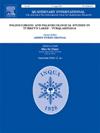Bone histology of Smilodon populator and Puma concolor from the Pleistocene of equatorial Brazil with comments on fossil diagenesis
IF 1.8
3区 地球科学
Q3 GEOGRAPHY, PHYSICAL
引用次数: 0
Abstract
Climate change over the last 50,000 years has significantly impacted large mammals. Large felids have been one of the groups most affected by these fluctuations. Palaeohistology is a tool for understanding the palaeobiological aspects of extinct species. Taphonomic analysis, in turn, allows us to understand the formation of fossil assemblages and palaeoclimatic characteristics. In this study, we sampled the femoral histology of the largest saber-toothed felid in the Americas, Smilodon populator (MCC-868V), and a fossil specimen of Puma concolor (MCC-991V), both from Quaternary deposits in Rio Grande do Norte, Northeast Brazil. The presence of EFS (External Fundamental System), generations of secondary osteons, and remodeled bone tissue indicate that both individuals had reached sexual maturity. However, MCC-868V was a young adult at the time of death, and MCC-991V was a senescent adult. Estimated mass for the S. populator specimen (157 kg) is lower than expected, even though the individual analyzed was a fully grown adult. There are no histopathological indicators that this S. populator individual underwent restrictions throughout its growth, which suggests a truly smaller individual. Smaller size may be a trait selected in a local population in Northeastern Equatorial Brazil due to the specific environmental and ecological conditions of the region. The morphometric analysis found that size did not correlate with bone thickness both among several felid taxa and within a Smilodon population. As no significant histological differences were found between P. concolor and S. populator. Fractures filled with iron oxide were found in both specimens. There is permineralization in S. populator and micritization in P. concolor.
巴西赤道地区更新世剑齿虎种群和美洲狮的骨组织学及化石成岩作用的评析
过去5万年的气候变化对大型哺乳动物产生了重大影响。大型猫科动物是受这些波动影响最大的群体之一。古生物学是了解灭绝物种的古生物学方面的工具。地层学分析,反过来,让我们了解化石组合的形成和古气候特征。在这项研究中,我们对美洲最大的剑齿猫科动物——Smilodon populator (MCC-868V)和美洲狮(Puma concolor, MCC-991V)的股骨组织学进行了采样,这两种动物都来自巴西东北部的里约热内卢Grande do Norte第四纪沉积物。EFS(外部基础系统)、继发性骨和重塑的骨组织的存在表明,这两个个体都达到了性成熟。然而,MCC-868V在死亡时是一个年轻的成虫,而MCC-991V是一个衰老的成虫。尽管所分析的个体是完全成年的个体,但种群样本的估计质量(157公斤)低于预期。没有组织病理学指标表明这个种群个体在整个生长过程中受到限制,这表明一个真正较小的个体。由于该地区特定的环境和生态条件,较小的体型可能是巴西赤道东北部当地种群选择的一种特征。形态计量学分析发现,在几个类群和一个剑齿虎种群中,大小与骨厚度没有相关性。由于两种植物在组织学上无显著差异。在两个标本中都发现了充满氧化铁的裂缝。在种群中存在过矿化现象,在花椒中存在微晶化现象。
本文章由计算机程序翻译,如有差异,请以英文原文为准。
求助全文
约1分钟内获得全文
求助全文
来源期刊

Quaternary International
地学-地球科学综合
CiteScore
5.60
自引率
4.50%
发文量
336
审稿时长
3 months
期刊介绍:
Quaternary International is the official journal of the International Union for Quaternary Research. The objectives are to publish a high quality scientific journal under the auspices of the premier Quaternary association that reflects the interdisciplinary nature of INQUA and records recent advances in Quaternary science that appeal to a wide audience.
This series will encompass all the full spectrum of the physical and natural sciences that are commonly employed in solving Quaternary problems. The policy is to publish peer refereed collected research papers from symposia, workshops and meetings sponsored by INQUA. In addition, other organizations may request publication of their collected works pertaining to the Quaternary.
 求助内容:
求助内容: 应助结果提醒方式:
应助结果提醒方式:


